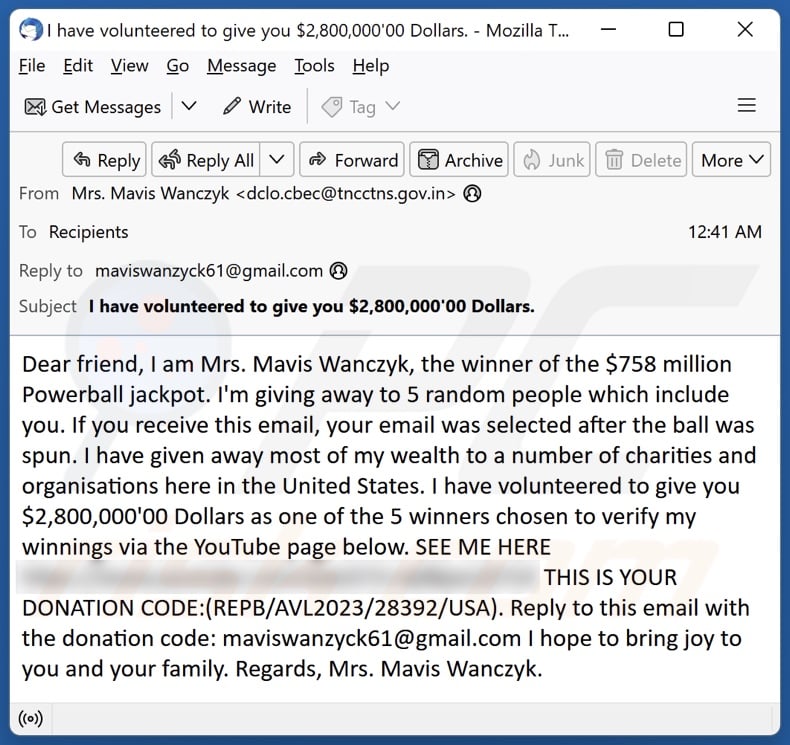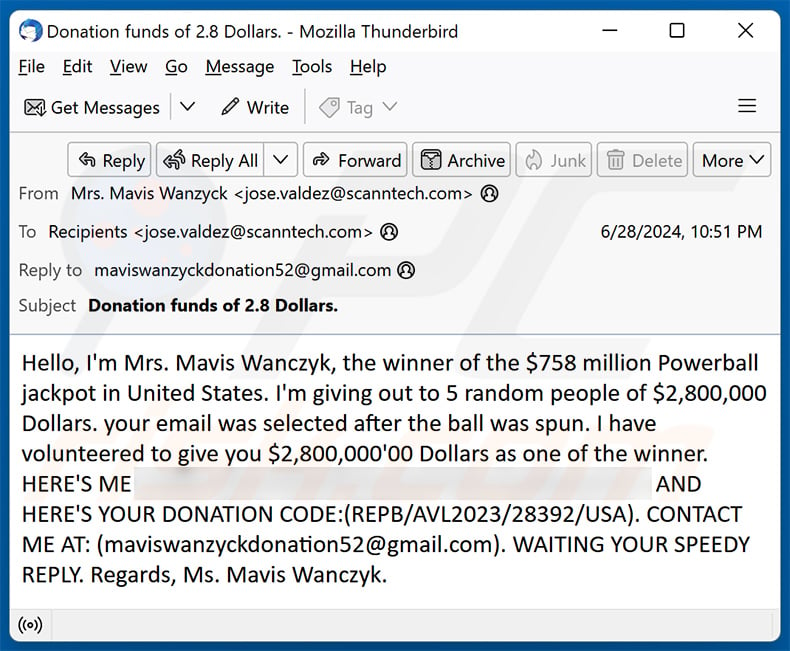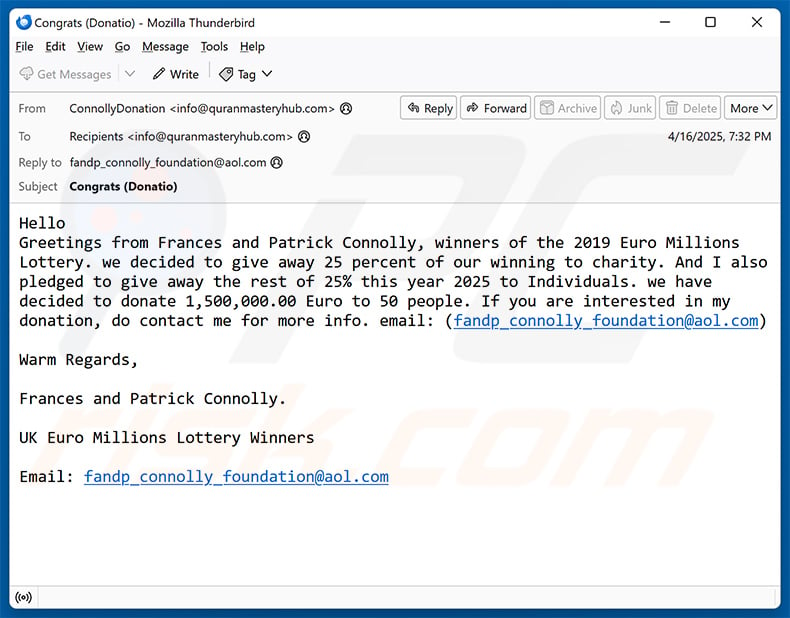Avoid getting scammed by fake "Giveaway Of Lottery Winnings" emails
Phishing/ScamAlso Known As: "Giveaway Of Lottery Winnings" spam email
Get free scan and check if your device is infected.
Remove it nowTo use full-featured product, you have to purchase a license for Combo Cleaner. Seven days free trial available. Combo Cleaner is owned and operated by RCS LT, the parent company of PCRisk.com.
What kind of email is "Giveaway Of Lottery Winnings"?
After reading the "Giveaway Of Lottery Winnings" email, we found it evident that this mail is spam. It informs the recipient that a lottery winner has randomly selected them to receive part of their winnings. This email likely operates as a phishing scam or seeks to trick victims into transferring funds to scammers.

"Giveaway Of Lottery Winnings" email scam overview
The spam email's subject states that the sender has volunteered to give the recipient 2.8 million USD. The body of the letter introduces the sender as a winner of the Powerball lottery 758 million USD jackpot. The winner has chosen to allocate part of their winnings to five random people, including this email's recipient.
The sender has already donated most of the prize to various charities and charitable organizations across the US. The letter then gives instructions to the recipient on how to verify their identity and contact the sender.
As mentioned in the introduction, all the information provided by this email is false, and this mail is not associated with the actual Powerball lottery or any real lottery winners.
Scams promoted by such emails can operate in a variety of ways. The schemes can be simplistic or incredibly elaborate. Phishing for sensitive information is one way that these scams can work.
Data of interest can include personally identifiable details, such as victims' names, ages, nationalities, occupations, addresses, contact information, etc. This data can be used to steal identities or carry out other nefarious deeds.
Finance-related information (e.g., financial/banking account log-in credentials, banking account details, debit/credit card numbers, etc.) may be sought as well. These details could be used to facilitate fraudulent transactions or online purchases.
Spam mail of this kind can also be used to deceive victims into sending money to scammers. Difficult-to-trace methods are utilized for this purpose, like cryptocurrencies, pre-paid vouchers, gift cards, or cash hidden in innocent-looking packages and shipped. Using these measures lowers the chances of successful prosecution and of victims retrieving their funds.
To summarize, by trusting an email like "Giveaway Of Lottery Winnings" users can experience severe privacy issues, significant financial losses, and even identity theft.
If you have provided personally identifiable or finance-related information to scammers, it may be necessary to contact the appropriate authorities without delay. And if you have disclosed your log-in credentials – immediately change the passwords of all possibly exposed accounts and inform their official support.
| Name | "Giveaway Of Lottery Winnings" spam email |
| Threat Type | Phishing, Scam, Social Engineering, Fraud |
| Fake Claim | Powerball lottery winner has randomly selected the email recipient to receive 2.8 million USD. |
| Symptoms | Unauthorized online purchases, changed online account passwords, identity theft, illegal access of the computer. |
| Distribution methods | Deceptive emails, rogue online pop-up ads, search engine poisoning techniques, misspelled domains. |
| Damage | Loss of sensitive private information, monetary loss, identity theft. |
| Malware Removal (Windows) |
To eliminate possible malware infections, scan your computer with legitimate antivirus software. Our security researchers recommend using Combo Cleaner. Download Combo CleanerTo use full-featured product, you have to purchase a license for Combo Cleaner. 7 days free trial available. Combo Cleaner is owned and operated by RCS LT, the parent company of PCRisk.com. |
Spam campaigns in general
We have investigated thousands of spam emails; "Shipping Receipt", "NORTON 360 Deluxe Purchase Invoice", "SSL (Secure Sockets Layer) Encryption", "Lack Of Mailbox Bandwidth", "HSBC Transfer Request", "Consignment Box", "Notification Concerning Your Netflix Account", and "Confirm Hotel Bank Account" are merely some of our latest articles.
Various scams are endorsed through this mail, and it is also used to proliferate malware. Spam emails are often plain and riddled with errors – however, they can also be competently made and even convincingly disguised as messages from legitimate entities (e.g., companies, organizations, institutions, service providers, authorities, etc.).
How do spam campaigns infect computers?
The use of spam campaigns is widespread in malware distribution. Deceptive emails/messages can include malicious files as attachments or download links. These files can be documents (Microsoft Office, Microsoft OneNote, PDF, etc.), executables (.exe, .run, etc.), archives (RAR, ZIP, etc.), JavaScript, and so on.
An infectious file triggers the malware download/installation chain upon being opened. However, some formats can require additional user interaction to jumpstart these processes. To elaborate some on this, Microsoft Office files need users to enable macro commands (i.e., editing/content), while OneNote documents require them to click embedded files/links.
How to avoid installation of malware?
Incoming emails, PMs/DMs, SMSes, and other messages must be approached with caution. We advise against opening attachments or links present in dubious mail, as they can be harmful/virulent.
However, malware is not distributed only through spam mail. Therefore, we also recommend vigilance while browsing, as fraudulent and malicious online content usually appears legitimate and innocuous.
Furthermore, all downloads must be made from official and verified channels. Another recommendation is to activate and update programs using functions/tools provided by genuine developers, as illegal activation ("cracking") tools and third-party updaters may contain malware.
Having a dependable anti-virus installed and kept up-to-date is essential to device and user safety. Security software must be used to perform regular system scans and to remove threats and issues. If you've already opened malicious attachments, we recommend running a scan with Combo Cleaner Antivirus for Windows to automatically eliminate infiltrated malware.
Text presented in the "Giveaway Of Lottery Winnings" spam email letter:
Subject: I have volunteered to give you $2,800,000'00 Dollars.
Dear friend, I am Mrs. Mavis Wanczyk, the winner of the $758 million Powerball jackpot. I'm giving away to 5 random people which include you. If you receive this email, your email was selected after the ball was spun. I have given away most of my wealth to a number of charities and organisations here in the United States. I have volunteered to give you $2,800,000'00 Dollars as one of the 5 winners chosen to verify my winnings via the YouTube page below. SEE ME HERE - THIS IS YOUR DONATION CODE:(REPB/AVL2023/28392/USA). Reply to this email with the donation code: maviswanzyck61@gmail.com I hope to bring joy to you and your family. Regards, Mrs. Mavis Wanczyk.
Other examples of emails from "Giveaway Of Lottery Winnings" spam campaign:
Sample 1:

Text presented within:
Subject: Donation funds of 2.8 Dollars.
Hello, I'm Mrs. Mavis Wanczyk, the winner of the $758 million Powerball jackpot in United States. I'm giving out to 5 random people of $2,800,000 Dollars. your email was selected after the ball was spun. I have volunteered to give you $2,800,000'00 Dollars as one of the winner. HERE'S ME ******** AND HERE'S YOUR DONATION CODE:(REPB/AVL2023/28392/USA). CONTACT ME AT: (maviswanzyckdonation52@gmail.com). WAITING YOUR SPEEDY REPLY. Regards, Ms. Mavis Wanczyk.
Sample 2:

Text presented within:
Subject: Congrats (Donatio)
Hello
Greetings from Frances and Patrick Connolly, winners of the 2019 Euro Millions Lottery. we decided to give away 25 percent of our winning to charity. And I also pledged to give away the rest of 25% this year 2025 to Individuals. we have decided to donate 1,500,000.00 Euro to 50 people. If you are interested in my donation, do contact me for more info. email: (fandp_connolly_foundation@aol.com)Warm Regards,
Frances and Patrick Connolly.
UK Euro Millions Lottery Winners
Email: fandp_connolly_foundation@aol.com
Instant automatic malware removal:
Manual threat removal might be a lengthy and complicated process that requires advanced IT skills. Combo Cleaner is a professional automatic malware removal tool that is recommended to get rid of malware. Download it by clicking the button below:
DOWNLOAD Combo CleanerBy downloading any software listed on this website you agree to our Privacy Policy and Terms of Use. To use full-featured product, you have to purchase a license for Combo Cleaner. 7 days free trial available. Combo Cleaner is owned and operated by RCS LT, the parent company of PCRisk.com.
Quick menu:
- What is "Giveaway Of Lottery Winnings" spam email?
- Types of malicious emails.
- How to spot a malicious email?
- What to do if you fell for an email scam?
Types of malicious emails:
![]() Phishing Emails
Phishing Emails
Most commonly, cybercriminals use deceptive emails to trick Internet users into giving away their sensitive private information, for example, login information for various online services, email accounts, or online banking information.
Such attacks are called phishing. In a phishing attack, cybercriminals usually send an email message with some popular service logo (for example, Microsoft, DHL, Amazon, Netflix), create urgency (wrong shipping address, expired password, etc.), and place a link which they hope their potential victims will click on.
After clicking the link presented in such email message, victims are redirected to a fake website that looks identical or extremely similar to the original one. Victims are then asked to enter their password, credit card details, or some other information that gets stolen by cybercriminals.
![]() Emails with Malicious Attachments
Emails with Malicious Attachments
Another popular attack vector is email spam with malicious attachments that infect users' computers with malware. Malicious attachments usually carry trojans that are capable of stealing passwords, banking information, and other sensitive information.
In such attacks, cybercriminals' main goal is to trick their potential victims into opening an infected email attachment. To achieve this goal, email messages usually talk about recently received invoices, faxes, or voice messages.
If a potential victim falls for the lure and opens the attachment, their computers get infected, and cybercriminals can collect a lot of sensitive information.
While it's a more complicated method to steal personal information (spam filters and antivirus programs usually detect such attempts), if successful, cybercriminals can get a much wider array of data and can collect information for a long period of time.
![]() Sextortion Emails
Sextortion Emails
This is a type of phishing. In this case, users receive an email claiming that a cybercriminal could access the webcam of the potential victim and has a video recording of one's masturbation.
To get rid of the video, victims are asked to pay a ransom (usually using Bitcoin or another cryptocurrency). Nevertheless, all of these claims are false - users who receive such emails should ignore and delete them.
How to spot a malicious email?
While cyber criminals try to make their lure emails look trustworthy, here are some things that you should look for when trying to spot a phishing email:
- Check the sender's ("from") email address: Hover your mouse over the "from" address and check if it's legitimate. For example, if you received an email from Microsoft, be sure to check if the email address is @microsoft.com and not something suspicious like @m1crosoft.com, @microsfot.com, @account-security-noreply.com, etc.
- Check for generic greetings: If the greeting in the email is "Dear user", "Dear @youremail.com", "Dear valued customer", this should raise suspiciousness. Most commonly, companies call you by your name. Lack of this information could signal a phishing attempt.
- Check the links in the email: Hover your mouse over the link presented in the email, if the link that appears seems suspicious, don't click it. For example, if you received an email from Microsoft and the link in the email shows that it will go to firebasestorage.googleapis.com/v0... you shouldn't trust it. It's best not to click any links in the emails but to visit the company website that sent you the email in the first place.
- Don't blindly trust email attachments: Most commonly, legitimate companies will ask you to log in to their website and to view any documents there; if you received an email with an attachment, it's a good idea to scan it with an antivirus application. Infected email attachments are a common attack vector used by cybercriminals.
To minimise the risk of opening phishing and malicious emails we recommend using Combo Cleaner Antivirus for Windows.
Example of a spam email:

What to do if you fell for an email scam?
- If you clicked on a link in a phishing email and entered your password - be sure to change your password as soon as possible. Usually, cybercriminals collect stolen credentials and then sell them to other groups that use them for malicious purposes. If you change your password in a timely manner, there's a chance that criminals won't have enough time to do any damage.
- If you entered your credit card information - contact your bank as soon as possible and explain the situation. There's a good chance that you will need to cancel your compromised credit card and get a new one.
- If you see any signs of identity theft - you should immediately contact the Federal Trade Commission. This institution will collect information about your situation and create a personal recovery plan.
- If you opened a malicious attachment - your computer is probably infected, you should scan it with a reputable antivirus application. For this purpose, we recommend using Combo Cleaner Antivirus for Windows.
- Help other Internet users - report phishing emails to Anti-Phishing Working Group, FBI’s Internet Crime Complaint Center, National Fraud Information Center and U.S. Department of Justice.
Frequently Asked Questions (FAQ)
Why did I receive this email?
Spam emails are not personal, even if they include details relevant to the recipients. Cyber criminals distribute this mail by the thousand with the hopes that at least some recipients will fall for the scams.
I have provided my personal information when tricked by this spam email, what should I do?
If you have disclosed personally identifiable or finance-related information (e.g., ID card details, passport photos/scans, credit card numbers, etc.) – immediately contact the appropriate authorities. However, if you have provided account credentials – change the passwords of all possibly exposed accounts and inform their official support without delay.
I have read a spam email but didn't open the attachment, is my computer infected?
Devices are infected when malicious attachments or links are opened; merely reading an email poses no infection threat.
I have downloaded and opened a file attached to a spam email, is my computer infected?
If the opened file was an executable (.exe, .run, etc.) – most likely, yes – the system was infected. However, you might have avoided compromising the device if it was a document (.doc, .xls, .one, .pdf, etc.). These formats may require extra interaction to initiate malware download/installation (e.g., enabling macro commands, clicking embedded content, etc.).
Will Combo Cleaner remove malware infections present in email attachments?
Yes, Combo Cleaner can detect and eliminate all manner of threats, including most of the known malware infections. Note that sophisticated malicious programs typically hide deep within systems – therefore, performing a full system scan is crucial.
Share:

Tomas Meskauskas
Expert security researcher, professional malware analyst
I am passionate about computer security and technology. I have an experience of over 10 years working in various companies related to computer technical issue solving and Internet security. I have been working as an author and editor for pcrisk.com since 2010. Follow me on Twitter and LinkedIn to stay informed about the latest online security threats.
PCrisk security portal is brought by a company RCS LT.
Joined forces of security researchers help educate computer users about the latest online security threats. More information about the company RCS LT.
Our malware removal guides are free. However, if you want to support us you can send us a donation.
DonatePCrisk security portal is brought by a company RCS LT.
Joined forces of security researchers help educate computer users about the latest online security threats. More information about the company RCS LT.
Our malware removal guides are free. However, if you want to support us you can send us a donation.
Donate
▼ Show Discussion